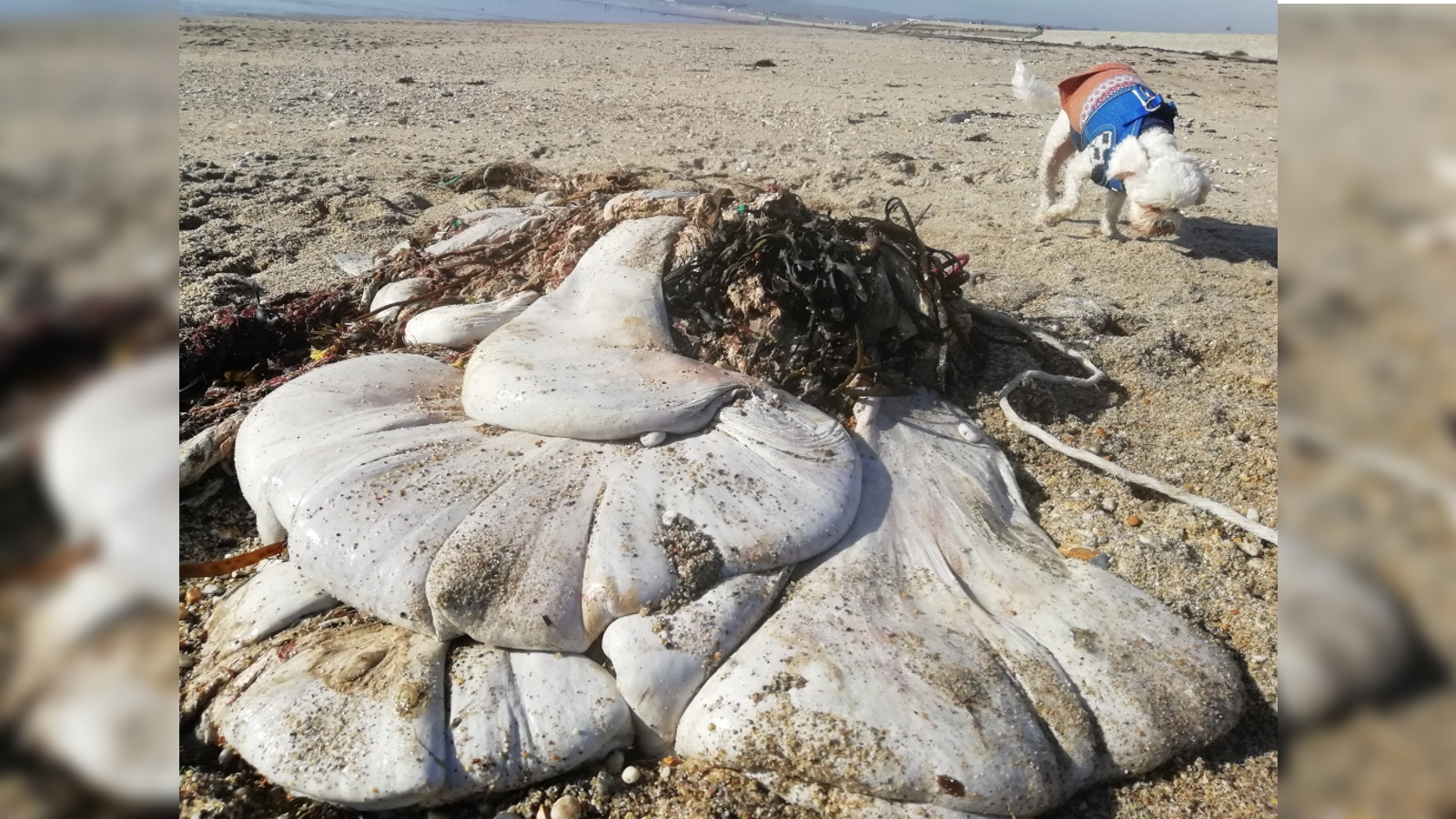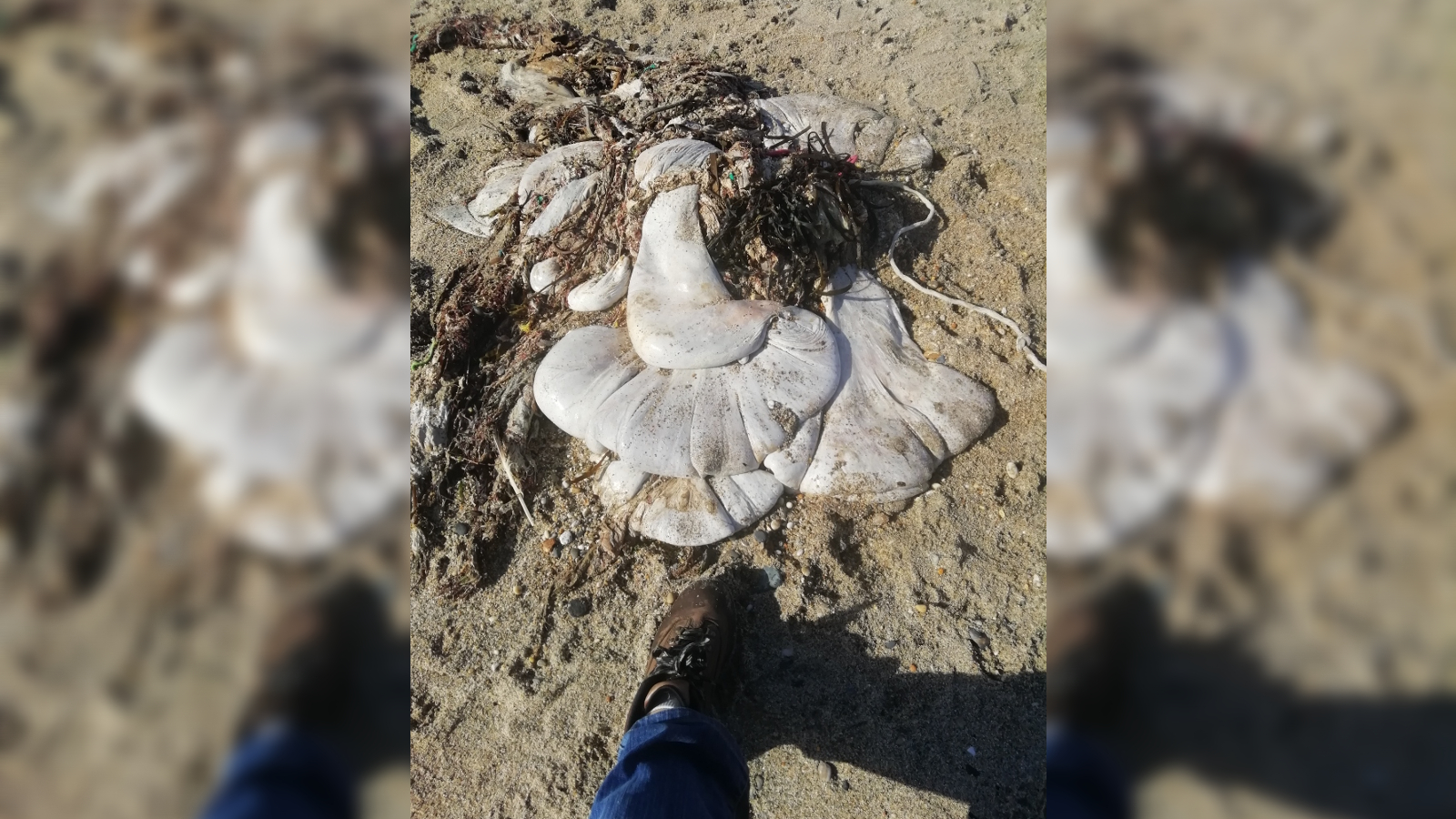Weird 'alien' sacks wash up on UK beach, most likely a whale's stomach
A dog-walker recently stumbled across a bizarre, white "fleshy lump" on a beach in Cornwall, England. Experts think that the unusual object is actually part of a whale's stomach.

A strange, alien-like blob of flesh recently left beach-goers "baffled" after it washed up on the U.K. shoreline. Experts believe that the unusual object is actually a pile of whale guts that floated ashore.
Local resident Helen Marlow discovered the bizarre remains on Oct. 27 at around 12 p.m. local time while walking her dog on Marazion Beach, near Penzance in Cornwall, England, Cornwall Live reported.
"It appeared to be a white, fleshy-looking substance," Marlow told Live Science in an email. "It had no definite features, such as limbs, but appeared to be one mass."
Marlow stumbled across the fleshy, seaweed-covered lump around halfway up the beach shortly after the tide had receded, which suggests that it had washed ashore.
It didn't have any "noticeable tears" or give off any "pungent, nasty or rotting smells," Marlow said. "I couldn't bring myself to touch it, but I did try to move it with my boot and, as I did, it wobbled a bit like a big, fat jelly."
Related: 11 strange things that washed ashore in 2021
Marlow's dog reacted with excitement and attempted to rub its body all over the mysterious lump, suggesting that the object was organic, Marlow said. But other than that, she had "no idea" what it could be. "I just couldn't recognize it or compare it to anything I had seen before," she added.
Sign up for the Live Science daily newsletter now
Get the world’s most fascinating discoveries delivered straight to your inbox.
Marlow uploaded photos of the fleshy lump to the British Marine Life Study Society Facebook group and received mixed guesses on what it could be. Suggestions included a whale placenta, sandbags and a deflated weather balloon.
The Facebook post soon caught the attention of the Cornwall Wildlife Trust's (CWT) Marine Strandings Network, which records all dead organic material that washes ashore in the area. Initially, the network's researchers suspected that the alien-looking material could indeed be a whale placenta. That would have been "really exciting," Abby Crosby, a marine conservation officer at CWT, told Live Science, because it would have meant that a baby whale had been born nearby recently, she added.

However, after consulting with experts at the U.K.'s Cetacean Strandings Investigation Programme (CSIP), it became clear that the gelatinous mass was actually a whale's stomach. It is unclear exactly which species of whale the stomach may have come from, but its size offers some clues.
"It's big," Crosby said, which means it must have come from a sizable whale species. A number of large whales regularly pass through U.K. waters, including fin whales (Balaenoptera physalus), minke whales (Balaenoptera acutorostrata) and humpback whales (Megaptera novaeangliae). Less frequent visitors include species such as sperm whales (Physeter macrocephalus) and bowhead whales (Balaena mysticetus), Crosby said.
Related: A blue whale's daily intake of microplastics weighs as much as a small person
The stomach likely came from a dead whale decomposing on the ocean surface far from the coast, she added
Small marine scavengers like seabirds typically focus on a dead cetacean's genital area because it is soft and already has an opening that they can tear even wider to reach the whale's flesh and blubber, Crosby said. As a result, "it's not unusual to see the underside of a dead cetacean get opened up," which could explain how the whale's internal organs spilled out, she added.
It is unclear how often whale stomachs may wash ashore like this, as people typically report sightings of complete carcasses but tend to ignore the "bits and bobs" that turn up on their own, she added. However, other whale body parts, including bones and blubber, do turn up on nearby beaches, she said.
Unfortunately, any opportunity to study the whale's stomach and learn more about it has now likely been lost. "I'm guessing it would have washed away with the next tide perhaps, or been eaten by sea birds or fish," Marlow said.
But for Crosby, the sighting is nonetheless very important. "It demonstrates that we have some of the ocean's giants living just off our coastline," which is something a lot of people in the U.K. simply don't realize, she said.

Harry is a U.K.-based senior staff writer at Live Science. He studied marine biology at the University of Exeter before training to become a journalist. He covers a wide range of topics including space exploration, planetary science, space weather, climate change, animal behavior and paleontology. His recent work on the solar maximum won "best space submission" at the 2024 Aerospace Media Awards and was shortlisted in the "top scoop" category at the NCTJ Awards for Excellence in 2023. He also writes Live Science's weekly Earth from space series.










